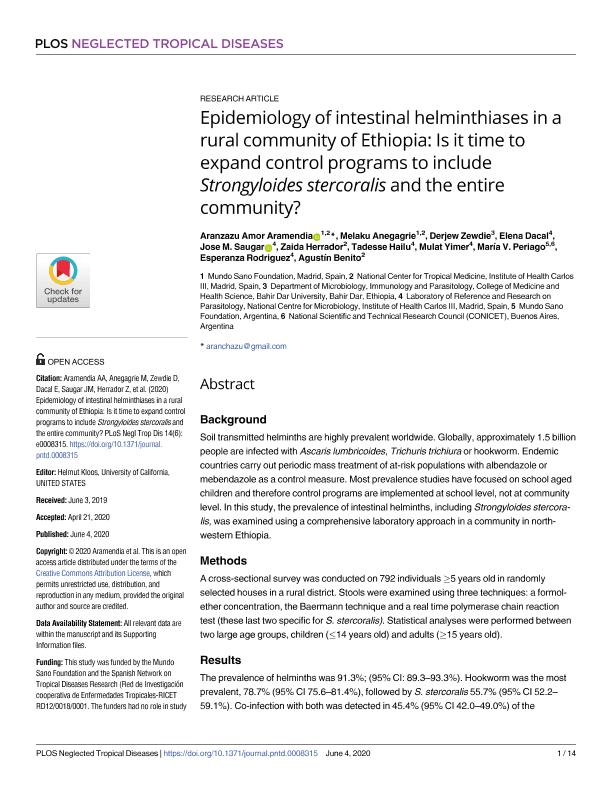Artículo
Epidemiology of intestinal helminthiases in a rural community of Ethiopia: Is it time to expand control programs to include strongyloides stercoralis and the entire community?
Amor Aramendia, Aranzazu; Anegagrie, Melaku; Zewdie, Derjew; Dacal, Elena; Saugar, Jose M.; Herrador, Zaida; Hailu, Tadesse; Yimer, Mulat; Periago, Maria Victoria ; Rodriguez, Esperanza; Benito, Agustín
; Rodriguez, Esperanza; Benito, Agustín
 ; Rodriguez, Esperanza; Benito, Agustín
; Rodriguez, Esperanza; Benito, Agustín
Fecha de publicación:
06/2020
Editorial:
Public Library of Science
Revista:
Neglected Tropical Diseases
ISSN:
1935-2735
Idioma:
Inglés
Tipo de recurso:
Artículo publicado
Clasificación temática:
Resumen
Background: Soil transmitted helminths are highly prevalent worldwide. Globally, approximately 1.5 billion people are infected with Ascaris lumbricoides, Trichuris trichiura or hookworm. Endemic countries carry out periodic mass treatment of at-risk populations with albendazole or mebendazole as a control measure. Most prevalence studies have focused on school aged children and therefore control programs are implemented at school level, not at community level. In this study, the prevalence of intestinal helminths, including Strongyloides stercoralis, was examined using a comprehensive laboratory approach in a community in northwestern Ethiopia. Methods: A cross-sectional survey was conducted on 792 individuals ≥5 years old in randomly selected houses in a rural district. Stools were examined using three techniques: a formolether concentration, the Baermann technique and a real time polymerase chain reaction test (these last two specific for S. stercoralis). Statistical analyses were performed between two large age groups, children (≤14 years old) and adults (≥15 years old). Results: The prevalence of helminths was 91.3%; (95% CI: 89.3–93.3%). Hookworm was the most prevalent, 78.7% (95% CI 75.6–81.4%), followed by S. stercoralis 55.7% (95% CI 52.2– 59.1%). Co-infection with both was detected in 45.4% (95% CI 42.0–49.0%) of the participants. The mean age of hookworm-infected individuals was significantly higher than non-infected ones (p = 0.003). Also, S. stercoralis infection was significantly associated with age, being more prevalent in adults (p = 0.002). Conclusions: This is the highest prevalence of S. stercoralis detected in Ethiopia so far. Our results high-light the need of searching specifically for infection by this parasite since it usually goes unnoticed if helminth studies rely only on conventional diagnostic techniques, i.e. Kato-Katz.Moreover, the focus of these programs on children undermines the actual prevalence of hookworm. The adult population acts as a reservoir for both hookworm and S. stercoralis and this fact may negatively impact the current control programs in Ethiopia which only target treatment of school aged children. This reservoir, together with a lack of adequate water, sanitation and hygiene, increases the probability of re-infection in children. Finally, the high prevalence of S. stercoralis found calls for a comprehensive diagnostic approach in endemic areas in addition to a revision of control measures that is, adding ivermectin to current alben-dazole/mebendazole, since it is the drug of choice for S. stercoralis.
Palabras clave:
SOIL-TRANSMITTED HELMINTHS
,
STRONGYLOIDES STERCORALIS
,
AMHARA
,
ETHIOPIA
Archivos asociados
Licencia
Identificadores
Colecciones
Articulos(SEDE CENTRAL)
Articulos de SEDE CENTRAL
Articulos de SEDE CENTRAL
Citación
Amor Aramendia, Aranzazu; Anegagrie, Melaku; Zewdie, Derjew; Dacal, Elena; Saugar, Jose M.; et al.; Epidemiology of intestinal helminthiases in a rural community of Ethiopia: Is it time to expand control programs to include strongyloides stercoralis and the entire community?; Public Library of Science; Neglected Tropical Diseases; 14; 6; 6-2020; 1-14
Compartir
Altmétricas



